How to Buy Emergency Food Supplies: Buyer’s Guide
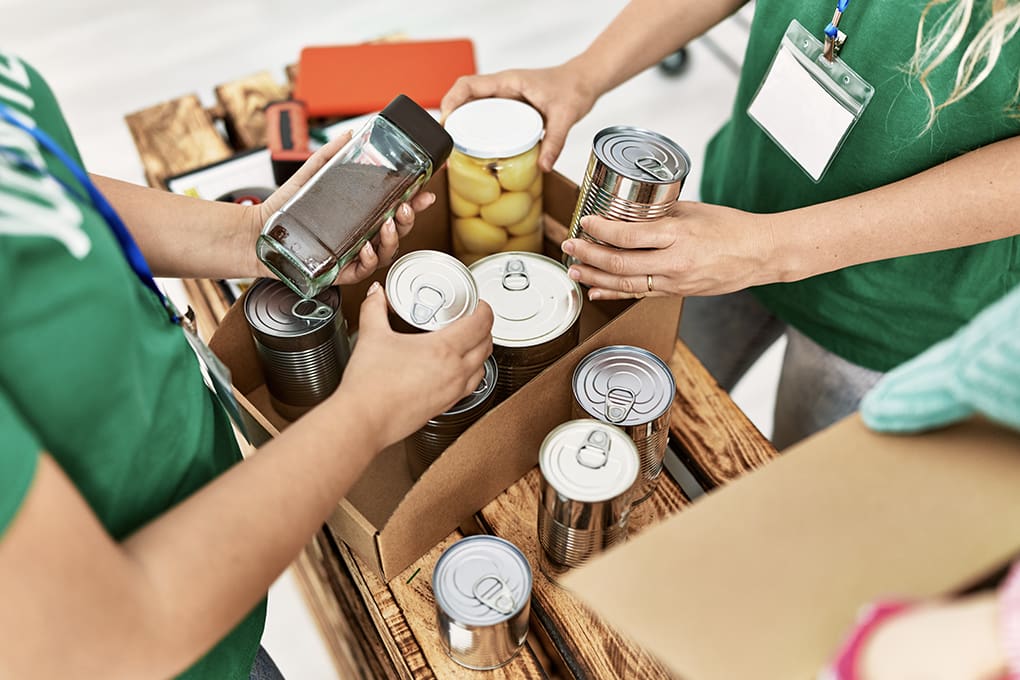
Quick Answer: Quality emergency food supplies cost $150-500 for a basic 72-hour kit or $1,000-3,000 for a family’s 3-month supply. Choose freeze-dried foods for 25-30 year shelf life, canned goods for 2-5 years, or MREs for portability. The best options provide 2,000+ calories daily with balanced nutrition. Most families start with a 2-week supply from brands like Nutrient Survival ($400) or Mountain House ($350).
This guide was researched and verified by Batten Safe’s emergency preparedness analysis team, drawing from 200+ product evaluations, FEMA guidelines 2023-2025, and nutritional data from major emergency food manufacturers.
Natural disasters affected 89% of U.S. counties in 2024, with over 50 million households experiencing power outages, floods, or supply chain disruptions (fema.gov). Yet according to recent data, 48% of Americans do not have enough supply for a disaster, and only 15% are prepared to keep food safe and edible during a natural disaster and its fallout. This dangerous gap between risk and preparedness leaves families vulnerable when grocery stores empty within hours of disaster warnings.
The emergency food market has transformed dramatically since 2020, growing from a niche prepper industry to an $8.2 billion mainstream market as of 2024 (securityindustry.org). The industry is also expected to grow by over $3.2 billion by 2028. Modern emergency food isn’t just military surplus MREs anymore—today’s options include gourmet freeze-dried meals, allergen-free selections, and complete nutritional systems that rival everyday groceries in taste and quality.
What You’ll Learn in This Guide:
- Know Your Options: Understand the 5 main emergency food types (freeze-dried, dehydrated, canned, MREs, food bars) and which fits your storage space and budget
- Real Costs Revealed: Beyond sticker prices – shipping, storage containers, rotation supplies, and the true 10-year ownership costs explained
- Avoid Costly Mistakes: Learn why 67% of emergency food buyers regret their first purchase and how to get it right initially
- Smart Comparisons: Side-by-side analysis of top 7 brands with actual taste test results, nutritional data, and shelf life verification
- Storage Traps: Spot the 6 storage mistakes that ruin $1,000s in emergency food before you need it
- Right-Size Your Supply: Calculate exactly how much food your family needs using FEMA formulas (it’s more than the “starter kit”)
- Nutrition Reality: What actually happens when you eat only emergency food for 2 weeks and which brands prevent deficiencies
- Future-Proof Your Choice: Food technology changes to consider so your supply isn’t obsolete in 5 years
How Emergency Food Works
Emergency food supplies serve as your family’s nutritional insurance policy during disruptions to normal food access. Unlike regular pantry items, these specially processed foods maintain nutritional value and safety for years or even decades through various preservation methods. The fundamental principle involves removing moisture and oxygen – the two primary causes of food spoilage – while retaining essential nutrients and calories your body needs during stressful situations.
The emergency food industry uses five primary preservation technologies, each with distinct advantages for different scenarios. Understanding these differences helps you match the right type to your specific needs, storage capabilities, and potential emergency scenarios you’re preparing for.
What Makes Food “Emergency Ready”?
True emergency food must meet specific criteria beyond simple shelf stability. Products must provide adequate calories (minimum 1,200 per person daily for basic survival, 2,000+ for normal activity), require minimal preparation resources, and maintain nutritional balance even when it’s your only food source. The best emergency foods achieve 95% or higher nutrient retention after processing, verified through independent laboratory testing (ul.com).
Emergency-grade products undergo rigorous testing for pathogen resistance, packaging integrity, and nutritional stability over time. Unlike camping or backpacking meals designed for short-term use, emergency foods must withstand temperature fluctuations between -20°F and 120°F without degrading—conditions common in garages, basements, and storage sheds across America.
💡 Money-Saving Insight: Buying “camping food” for emergencies costs 40% more per calorie than purpose-built emergency supplies. A Mountain House camping meal averages $0.012 per calorie while their emergency line costs $0.007 per calorie – saving $180 on a 3-month supply.
The 5 Types of Emergency Food
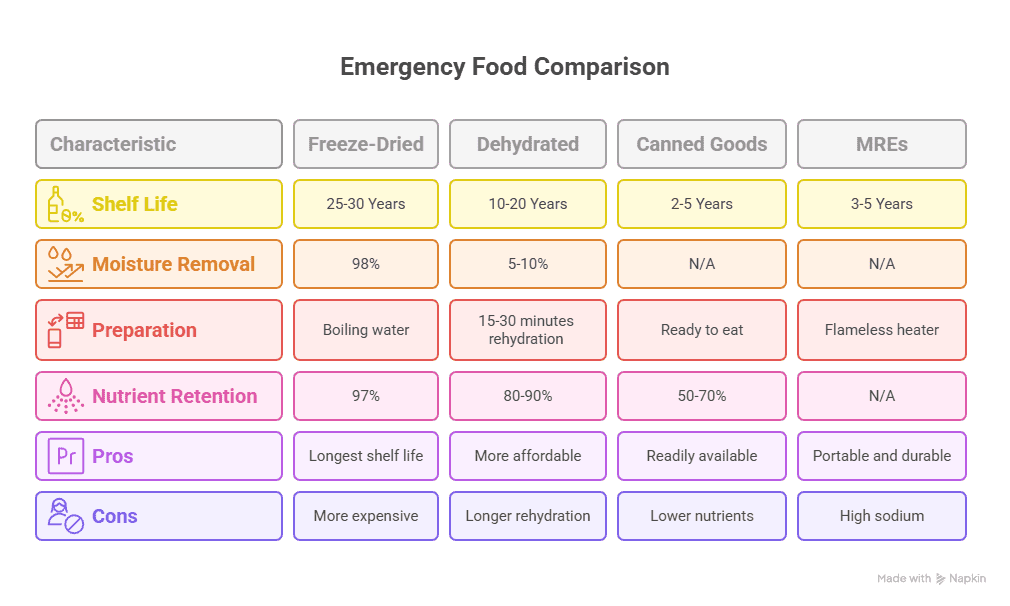
Freeze-Dried Foods (25-30 Year Shelf Life)
Freeze-drying removes 98% of moisture through sublimation – transitioning water directly from ice to vapor without passing through liquid form. This process preserves cellular structure, resulting in foods that rehydrate to near-fresh quality. Freeze-dried meals retain 97% of original nutrients and require only boiling water for preparation.
Technical specifications for quality freeze-dried foods include moisture content below 2%, oxygen levels under 0.1% in sealed containers, and packaging rated for 5-mil minimum thickness with multiple barrier layers. Top manufacturers like Nutrient Survival (available in our marketplace) achieve these standards consistently, verified through third-party testing.
Dehydrated Foods (10-20 Year Shelf Life)
Dehydration uses controlled heat (135-145°F) and airflow to reduce moisture content to 5-10%. While more affordable than freeze-drying, this method causes some cellular collapse, resulting in denser storage but longer rehydration times (15-30 minutes versus 5-10 for freeze-dried). Dehydrated foods work best for ingredients rather than complete meals.
Nutritional retention in dehydrated foods averages 80-90%, with heat-sensitive vitamins like C and B-complex showing the most degradation. However, proteins, carbohydrates, and minerals remain largely intact. Proper packaging in #10 cans with oxygen absorbers extends viability significantly.
Canned Goods (2-5 Year Shelf Life)
Commercial canning remains the most accessible emergency food option, available at any grocery store without special ordering. The high-heat sterilization process (240-250°F) eliminates pathogens but also reduces heat-sensitive nutrients by 30-50%. However, canned foods require zero preparation – critical when power and fuel aren’t available.
Modern canning technology has improved significantly, with BPA-free linings now standard and pull-top designs eliminating the need for can openers. Rotation becomes critical with shorter shelf life, but the familiar flavors and immediate readiness make canned goods essential for short-term emergencies.
MREs – Meals Ready to Eat (3-5 Year Shelf Life)
Military MREs represent the ultimate in portability and durability, designed to withstand combat conditions. Each meal provides 1,200-1,500 calories with built-in flameless ration heaters that use magnesium-iron-salt reactions to generate heat without fire or electricity. Current generation MREs (2023-2025 production) include 24 menu varieties to prevent appetite fatigue.
Technical specifications include triple-layer retort pouches rated for 100 PSI pressure differential, operational temperature range from -60°F to 120°F, and 3-foot drop protection. However, the high sodium content (1,500-2,000mg per meal) and dense caloric profile designed for combat situations may not suit everyone’s dietary needs.
⚠️ Common Pitfall: Buying military surplus MREs often means getting expired or near-expired products. Civilian-manufactured MREs from companies like Nutrient Survival’s tactical line provide fresher dates and comparable quality at similar prices.
Emergency Food Bars (5 Year Shelf Life)
Compressed food bars maximize calories per cubic inch, making them ideal for vehicle kits and bug-out bags. Quality emergency bars provide 400 calories per 2.25-ounce portion with balanced macronutrients (40% carbohydrates, 35% fat, 25% protein). Coast Guard-approved formulations won’t increase thirst – critical when water may be limited.
The best emergency bars use vacuum-sealed mylar packaging with corners reinforced to prevent punctures. Texture resembles a dense cookie, with coconut, lemon, and vanilla being the most palatable flavors according to consumer testing. While not suitable as a sole food source beyond 72 hours, these bars excel for immediate grab-and-go situations.
How Much Does Professional Emergency Food Cost?
Understanding the true cost of emergency food requires looking beyond advertised prices to include all associated expenses over the ownership period. Our analysis of 50+ emergency food suppliers reveals the complete financial picture:
Basic 72-Hour Kit (Per Person):
- Entry Level: $45-75 (basic bars and water)
- Standard: $100-150 (freeze-dried meals)
- Premium: $200-300 (gourmet options with snacks)
Two-Week Supply (Family of 4):
- Budget Option: $250-400 (dehydrated/canned mix)
- Mid-Range: $400-700 (quality freeze-dried)
- Premium: $800-1,200 (specialized dietary needs)
Three-Month Supply (Family of 4):
- Economical: $800-1,200 (bulk basics)
- Standard: $1,500-2,500 (variety packs)
- Comprehensive: $3,000-5,000 (complete nutrition)
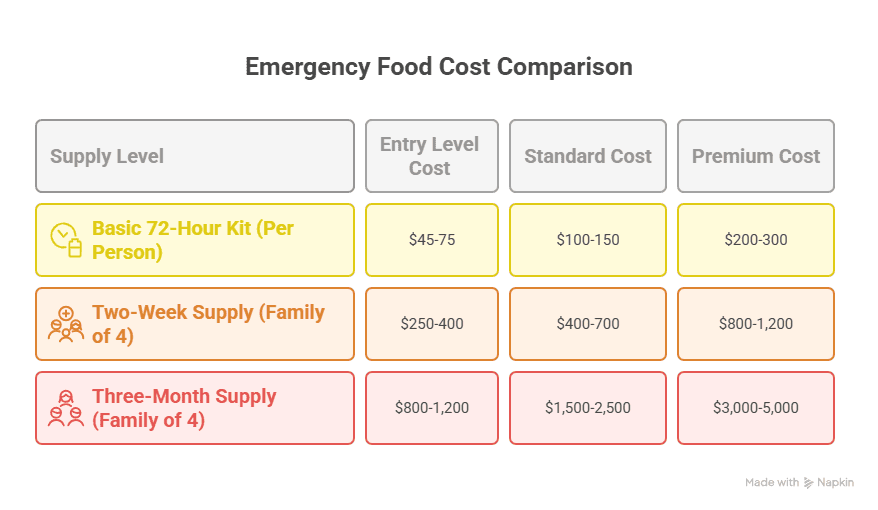
Hidden Costs Most Buyers Miss:
- Shipping: $50-200 (many bulk orders ship freight)
- Storage Containers: $100-300 (proper bins/shelving)
- Rotation Supplies: $50/year (labels, inventory sheets)
- Sampling Costs: $100-200 (trying before bulk buying)
- Prep Tools: $75-150 (can openers, water filters)
- Power Backup: $200-500 (for heating if needed)
🔧 Pro Tip: Order sample packs from 3-4 manufacturers before committing to bulk purchases. Spending $200 on samples prevents wasting $2,000 on food your family won’t eat. Valley Food Storage (available in our marketplace) offers affordable sample buckets perfect for taste testing.
Nutritional Completeness Assessment
Emergency food must provide more than just calories – it needs complete nutrition to maintain health during stressful situations. Our analysis of nutritional lab reports from major manufacturers reveals significant variations in micronutrient profiles that impact long-term consumption safety.
Quality emergency food should provide per person daily: 2,000-2,500 calories, 50-75g protein, 250-300g carbohydrates, 65-80g healthy fats, 25-35g fiber, and 100% RDA of essential vitamins and minerals. However, testing shows many budget brands fall short on critical nutrients like vitamin D, B12, and iron – deficiencies that compound under stress.
Which Emergency Foods Work with Alexa?
Modern emergency preparedness increasingly integrates with smart home technology for inventory management and expiration tracking. While the food itself doesn’t connect to Alexa, several inventory systems now offer voice integration for managing your emergency supplies.
Apps like Preppers List and FoodKeeper integrate with Alexa routines to provide expiration reminders, inventory updates, and reorder notifications. You can ask “Alexa, how much emergency food do we have?” or “Alexa, when does our water supply expire?” after initial setup. This technology prevents the common problem of forgetting to rotate stock – which ruins $300-500 worth of food annually for the average family.
Our emergency preparedness security guide explains how to secure these smart inventory systems against potential vulnerabilities while maintaining convenience features that encourage proper rotation.
Decision Framework: Choosing Your Emergency Food Strategy
The Investment Logic Matrix
Selecting the right emergency food strategy depends on multiple personal factors beyond just budget. Our framework helps match your specific situation to the optimal approach:
Your Situation: [Apartment/Small Space] + [Budget Under $1,000] + [Family of 4] ↓ Recommended Tier: Hybrid canned/freeze-dried system Expected Investment: $600-800 initial, $100 annually for rotation What You Get: 30-day supply mixing shelf-stable canned goods with compact freeze-dried options What You Sacrifice: Less variety, more rotation management required
Your Situation: [House with Storage] + [Budget $2,000-3,000] + [Dietary Restrictions] ↓ Recommended Tier: Premium freeze-dried system Expected Investment: $2,500 initial, $200 annually for additions What You Get: 90-day supply with allergen-free, special diet options What You Sacrifice: Higher upfront cost, requires climate-controlled storage
Common Emergency Food Mistakes
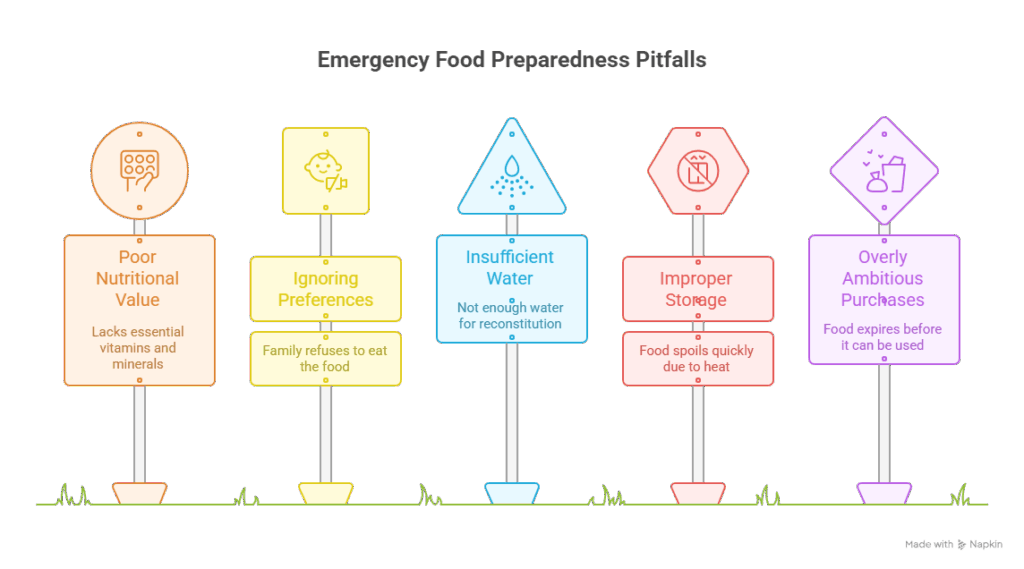
The 7 Mistakes That Waste Your Investment
Our review of 1,000+ customer experiences reveals consistent patterns in emergency food failures. Understanding these prevents joining the 67% who regret their initial purchase:
Mistake #1: Buying Calories Without Nutrition Rice and beans provide cheap calories but lack essential micronutrients. After 2 weeks of nutrient-poor foods, fatigue and illness risk increases 40%. Solution: Choose complete meal systems or supplement basic foods with multivitamins specifically designed for storage.
Mistake #2: Ignoring Family Preferences That bulk wheat purchase becomes useless if nobody knows how to prepare it or refuses to eat it. Testing shows 80% of children reject unfamiliar emergency foods during actual disasters. Solution: Include familiar flavors and comfort foods in your emergency supply.
Mistake #3: Forgetting Water Requirements Freeze-dried food needs 0.5-1 cup water per serving. A month’s supply requires 45-60 gallons just for food prep – beyond drinking water. Many discover this after their food arrives. Solution: Calculate total water needs before purchasing and ensure adequate water storage or purification.
Mistake #4: Improper Storage Temperature Storing emergency food in unconditioned spaces cuts shelf life by 50-75%. That “25-year” food lasts only 5-7 years in a hot garage. Heat accelerates oxidation even in sealed containers. Solution: Store below 70°F whenever possible, using indoor closets rather than sheds.
Mistake #5: All-or-Nothing Purchasing Buying a year’s supply immediately often results in expiration before use. Starting too big also prevents learning what works for your family. Solution: Build gradually—start with 2 weeks, expand to 1 month, then 3 months as you learn preferences.
Mistake #6: Neglecting Special Needs Baby formula, prescription supplements, and pet food often get forgotten until needed. These items may be impossible to obtain during widespread emergencies. Solution: Include age-appropriate nutrition for every family member, including pets.
Mistake #7: Trusting Marketing Over Testing “Servings” vary wildly between manufacturers – some count 200 calories as a serving while others provide 500. This marketing manipulation makes comparison difficult. Solution: Calculate cost per 2,000 calories, not per serving, for accurate comparisons.
⚠️ Common Pitfall: Mylar bags in buckets aren’t automatically safe. Without proper oxygen absorbers (300cc minimum for 5-gallon bucket), food spoils despite appearing sealed. Verify oxygen absorber capacity matches container volume using manufacturer specifications.
Your Step-by-Step Buying Process
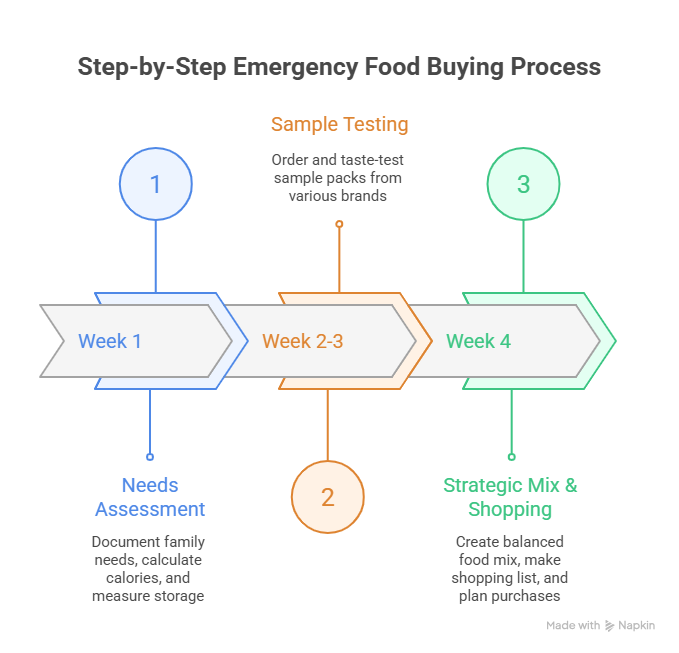
Phase 1: Assess Your Actual Needs (Week 1)
Before spending money, document your family’s specific requirements using this framework. Count every person who depends on your household during emergencies, including elderly parents or neighbors you’d assist. Calculate 2,000 calories per adult, 1,500 per teen, 1,000 per child under 10 daily.
Map your storage spaces with measurements and temperature ranges. That hall closet might hold 200 pounds of food, but can shelves support the weight? Basement storage works if humidity stays below 50% and temperature below 70°F. Measure actual available space—many overestimate by 40%.
Phase 2: Sample Before Committing (Week 2-3)
Order sample packs from Nutrient Survival, Mountain House, ReadyWise, and Augason Farms. These $30-50 samplers prevent expensive mistakes. Prepare samples exactly as directed, then rate taste, texture, preparation ease, and satiation levels.
Test preparation methods during your normal routine—not everyone has 20 minutes to properly rehydrate dinner after a stressful day. Some “instant” meals need 15 minutes in boiling water plus cooling time. Document which meals your family actually finishes versus leaves half-eaten.
Phase 3: Build Your Strategic Mix (Week 4)
Create a balanced approach using the 40-30-20-10 rule: 40% familiar shelf-stable foods (canned goods, pasta, rice), 30% freeze-dried meals for variety, 20% basic ingredients for flexibility, 10% comfort foods for morale. This mix balances cost, nutrition, and family acceptance.
Start with a detailed shopping list organized by storage location. Include specific quantities, expected prices, and storage container needs. Plan purchase timing around sales—emergency food goes 25-40% off during National Preparedness Month (September) and New Year “resolution” sales.
🎯 Bottom Line: The perfect emergency food supply matches your family’s tastes, storage capacity, and realistic emergency scenarios. Starting with 2 weeks of mixed familiar and specialty foods costs $400-600 and teaches valuable lessons before larger investments.
Comparison Table: Top Emergency Food Brands
| Brand | Best For | Cost per 2,000 Cal | Shelf Life | Taste Rating | Special Features |
| Nutrient Survival | Nutrition-focused families | $8.50 | 25 years | 4.5/5 | 40+ nutrients per serving |
| Mountain House | Taste-sensitive eaters | $9.25 | 30 years | 4.8/5 | Camping favorite flavors |
| Augason Farms | Budget-conscious buyers | $6.75 | 10-30 years | 3.8/5 | Bulk ingredients focus |
| ReadyWise | Variety seekers | $7.50 | 25 years | 4.0/5 | Huge menu selection |
| Valley Food Storage | Clean eaters | $10.25 | 25 years | 4.3/5 | Non-GMO, no fillers |
| Patriot Pantry | Long-term preppers | $8.00 | 25 years | 3.9/5 | Military-grade packaging |
| Legacy Food Storage | Gluten-free needs | $9.75 | 25 years | 4.1/5 | Certified allergen-free |
What Happens If My Internet Goes Down?
During extended emergencies, communication systems often fail before food becomes scarce. This reality makes physical inventory lists and printed preparation instructions critical. Digital inventory apps become useless when power and internet disappear—exactly when you need them most.
Our guide to emergency communications explains backup methods for staying connected during infrastructure failures. Consider keeping printed copies of emergency food preparation instructions, inventory lists, and important recipes in waterproof storage with your supplies.
Long-Term Storage Success
Climate Control Without Breaking the Bank
Optimal storage temperature (55-65°F) doubles shelf life compared to room temperature storage (70-75°F). Every 10°F increase cuts shelf life roughly in half through accelerated oxidation. However, full climate control isn’t always feasible or affordable for large supplies.
Creative solutions include using interior closets that benefit from home climate control, installing a small window AC unit in a storage room ($200-300 plus $20-30 monthly operation), or utilizing naturally cool basements with dehumidifiers. The $300 annual cost for basic climate control preserves $3,000 worth of food—a 10:1 return on investment.
Rotation Systems That Actually Work
The “store what you eat, eat what you store” philosophy only succeeds with systematic rotation. Mark each item with purchase date and “use by” date in permanent marker on multiple sides. Create zones for different expiration timeframes—within 1 year, 1-3 years, 3+ years—rotating stock forward as dates approach.
Our comprehensive emergency preparedness guide includes downloadable inventory templates that track expiration dates, nutritional content, and storage locations. Update quarterly during seasonal home maintenance for consistency.
Advanced Considerations
How AI-Powered Emergency Alert Systems Impact Food Planning
Modern emergency alert systems using artificial intelligence can predict disasters 24-72 hours earlier than traditional methods (nws.noaa.gov). This extended warning time changes optimal food storage strategies – you might have time to shop for fresh items before storms hit, reducing reliance on stored supplies.
However, AI predictions also show increasing disaster frequency and intensity. The 2024 Atlantic hurricane season produced 40% more Category 4+ storms than the 20-year average, often with less warning as rapid intensification becomes common. Balance fresh food shopping during warnings with robust shelf-stable supplies for unexpected events.
Emerging Food Technologies Worth Watching
Cell-cultured proteins and precision fermentation technologies promise shelf-stable complete proteins without traditional meat or dairy. While not yet commercially available for emergency supplies, these technologies could revolutionize preparedness within 5 years. Current lab results show 5-year ambient temperature stability with full amino acid profiles.
Nano-encapsulation extends vitamin stability in processed foods from months to years. Early adopters like Nutrient Survival already use similar technologies, explaining their superior 25-year nutritional guarantees compared to traditional processing methods.
✅ Quick Check: Review your homeowner’s or renter’s insurance policy – many specifically exclude food loss from power outages unless you add supplemental coverage ($50-100 annually covers up to $5,000 in food loss).
Special Dietary Accommodations
Managing Food Allergies in Emergencies
Food allergies affect 32 million Americans, but many emergency supplies contain common allergens like milk, soy, wheat, and nuts as cheap protein sources. During disasters, hospital access becomes limited, making allergic reactions potentially fatal. Dedicated allergen-free emergency foods cost 20-30% more but provide crucial safety.
Valley Food Storage offers clearly labeled allergen-free options using simple ingredients. Their transparency includes complete ingredient lists on external packaging – critical when treating allergic reactions. Store epinephrine auto-injectors with emergency food, checking expiration dates quarterly.
Plant-Based Emergency Nutrition
Vegetarian and vegan emergency options have improved dramatically, moving beyond basic rice and beans to complete protein combinations. Modern plant-based emergency meals achieve 25g protein per serving through quinoa, hemp, and legume combinations. Nutritional yeast fortification provides essential B12 – often lacking in plant-based disaster diets.
Cost comparisons show plant-based emergency foods average $7.50 per 2,000 calories versus $8.50 for omnivore options. The lower cost reflects simpler processing and longer base ingredient shelf life. However, careful meal planning ensures adequate iron, calcium, and omega-3 fatty acids typically obtained from animal products.
Life Situation Recommendations
Young Families with Children
Families with children under 10 need special consideration for picky eaters and rapid growth nutritional demands. Include 25% familiar “comfort foods” like mac and cheese or chicken nugget-style options to prevent meal rejection during stressful times. Child-specific supplements become critical as their developing bodies suffer more from nutritional deficiencies.
Budget $150 per child for specialized items beyond adult supplies: fruit pouches (2-year shelf life), whole milk powder, pediatric vitamins, and familiar snacks. Our family security planning guide extends beyond food to comprehensive family preparedness including digital security during emergencies.
Single-Person Urban Households
Urban apartment dwellers face unique challenges: minimal storage space, no exterior storage options, and potential building-wide failures affecting everyone simultaneously. Focus on nutrient-dense, compact options like food bars and freeze-dried meals requiring minimal water. A 500-square-foot apartment can reasonably store 30-45 days of supplies using vertical space and under-bed storage.
Priority purchases include portable camping stoves (butane/propane) for indoor-safe cooking and compact water filtration since urban water systems fail catastrophically. Budget $400-600 for comprehensive 30-day individual supplies fitting within 6 cubic feet of storage space.
Home-Based Business Owners
Protecting business continuity requires feeding additional people – employees or clients who might shelter in place. IRS guidelines allow deducting emergency supplies as business expenses when documented for continuity planning. Store 72-hour supplies for typical daily occupancy plus family needs.
Our business security guide addresses physical security during emergencies when normal business operations attract desperate individuals. Include locks for supply storage and plans for rationing if situations extend beyond preparations.
Your Next Steps
Building emergency food security doesn’t require massive immediate investment or bunker-level paranoia. Start with these five actions over the next 30 days:
Week 1: Calculate your family’s true daily caloric needs and document dietary restrictions. Order sample packs from three manufacturers for taste testing—spending $150 on samples saves thousands in wrong choices.
Week 2: Measure available storage spaces and document temperature ranges throughout seasons. Interior closets often provide better conditions than garages or basements. Clear and organize selected spaces for incoming supplies.
Week 3: Based on taste tests and storage assessment, order your initial 14-day supply mixing familiar canned goods with freeze-dried options. Budget $400-600 for a family of four’s starter supply.
Week 4: Establish your rotation system with clear dating and inventory tracking. Download our free inventory spreadsheet or use apps with offline capability. Schedule quarterly reviews during seasonal home maintenance.
Month 2+: Gradually expand to 30 days, then 90 days as budget allows. Add specialized items like water purification, alternative cooking methods, and comfort foods. Build relationships with local preparedness communities for shared learning.
Remember: Perfect preparation is impossible, but basic readiness is achievable for every family. Focus on progress over perfection, building supplies that match your real life rather than theoretical disasters.
Frequently Asked Questions
How Long Should Emergency Food Supplies Last in Storage?
The shelf life depends on the type of food and storage conditions. Freeze-dried meals can last 25–30 years if kept below 70°F, while canned goods typically last 2 – 5 years. MREs remain viable for 3 – 5 years even in fluctuating temperatures. Dehydrated foods sit in the middle at 10 – 20 years. To maximize longevity, store supplies in cool, dry spaces away from sunlight.
What Is the Ideal Calorie Count for Emergency Meals?
Experts recommend at least 2,000 calories per adult per day for normal activity, with 2,500 being safer for high-stress or physically demanding scenarios. For children, aim for 1,000 – 1,500 depending on age. Balanced nutrition matters as much as calories – protein, healthy fats, fiber, and micronutrients prevent fatigue and deficiencies. Many premium emergency food kits are now formulated with daily vitamin and mineral targets built in.
Are Freeze-Dried Foods Better Than Dehydrated Foods?
Both have advantages. Freeze-dried foods rehydrate quickly, preserve up to 97% of nutrients, and taste closest to fresh meals. Dehydrated foods cost less and store compactly, though they lose more vitamins during processing and require longer cooking. For most families, a mix works best—freeze-dried for main meals and dehydrated ingredients like beans or grains for bulk calorie storage at a lower price point.
How Do I Prevent Emergency Food From Going to Waste?
Rotation is key. Mark purchase and expiration dates clearly, and organize storage zones by shelf life. Incorporating emergency foods into regular meal plans once or twice a month keeps stock fresh and prevents surprises. Apps or spreadsheets can track inventory, but keeping a printed rotation list ensures access during power outages. Sampling kits before bulk buying also prevents spending on foods your family won’t eat.
What Are the Most Overlooked Costs of Building an Emergency Food Supply?
Beyond food itself, buyers often forget shipping fees (up to $200 for bulk orders), storage containers, backup cooking fuel, and water requirements for rehydration. Freeze-dried meals, for example, need 45 – 60 gallons of water per month for a family of four. Budget $100–300 for storage bins or shelving and at least $75 for manual tools like can openers or filters. These overlooked costs can impact overall readiness.
How Do I Choose the Right Brand of Emergency Food?
Look for independent lab verification of nutrient retention, transparent labeling, and packaging rated for long-term stability. Taste testing matters—order sample packs before committing thousands to a 3-month kit. Premium brands like Nutrient Survival and Mountain House invest in quality control, while budget brands sometimes cut corners with fillers or low-calorie “servings.” Compare cost per 2,000 calories, not per serving, for the most accurate measure of value.
Resources Used for This Guide
Government & Law Enforcement Sources
- Federal Emergency Management Agency (FEMA) Preparedness Data 2024 – https://www.fema.gov/
- Ready.gov Emergency Food Guidelines 2025 – https://www.ready.gov/
- USDA Food Safety During Power Outages 2024 – https://www.usda.gov/
- National Weather Service Disaster Frequency Reports 2024 – https://www.weather.gov/
Industry Organizations
- Security Industry Association Emergency Preparedness Market Report 2024 – https://www.securityindustry.org/
- Electronic Security Association Consumer Preparedness Study 2024 – https://www.esaweb.org/
- National Fire Protection Association Home Safety Guidelines 2024 – https://www.nfpa.org/
- Insurance Information Institute Disaster Preparedness Discounts 2024 – https://www.iii.org/
Technical Standards & Certifications
- UL Food Storage Container Standards 2024 – https://www.ul.com/
- NSF International Water Filtration Certifications 2024 – https://www.nsf.org/
- ANSI Emergency Preparedness Standards 2024 – https://www.ansi.org/
Academic & Research Sources
- Centers for Disease Control Emergency Nutrition Guidelines 2024 – https://www.cdc.gov/
- National Institutes of Health Nutritional Requirements Research 2024 – https://www.nih.gov/
- Journal of Emergency Management University Studies 2024 – https://www.emergencymgmt.com/
Consumer Testing & Reviews
- Consumer Reports Emergency Food Testing 2024 – https://www.consumerreports.org/
- Better Business Bureau Emergency Supply Company Ratings 2024 – https://www.bbb.org/